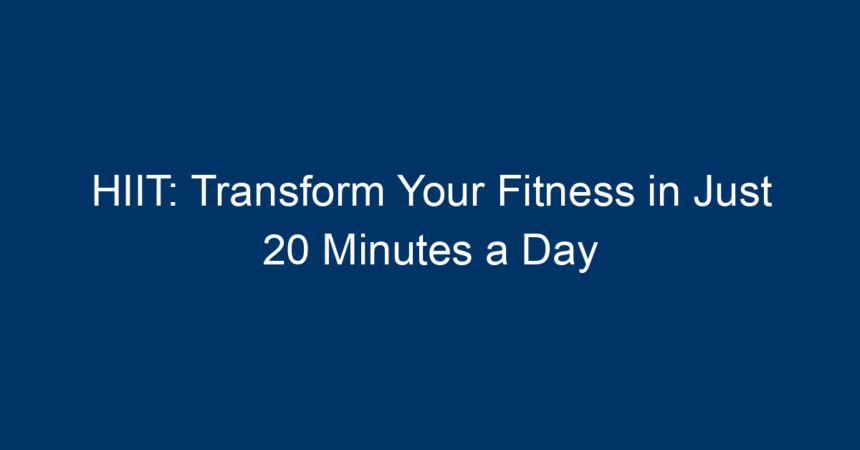In today’s fast-paced world, finding time to exercise can often feel impossible. Enter HIIT—High-Intensity Interval Training—an efficient workout regimen that packs a punch in just 20 minutes a day. Whether you’re a seasoned athlete or a fitness novice, HIIT can transform your body and boost your overall health. This article will explore the science behind HIIT, its benefits, different workout styles, and how to effectively incorporate it into your daily routine.
What is HIIT?
HIIT involves short bursts of intense exercise alternated with low-intensity recovery periods. Typically lasting from 20 to 30 minutes, these workouts are designed to elevate your heart rate and keep it elevated, resulting in maximum calorie burn even after you leave the gym. This time-efficient workout style is loaded with benefits, making it a popular choice among fitness enthusiasts.
A Brief History of HIIT
HIIT has become a buzzword in the fitness community, but the concept isn’t new. It dates back to the early 1900s when exercise scientists experimented with interval training to improve athletes’ performance. Over the years, the methodology has evolved, gaining traction in gyms and among personal trainers looking to help clients maximize workout efficiency.
The Science Behind HIIT
Understanding how HIIT works can help you appreciate its efficiency.
Metabolic Boost
HIIT workouts elevate your metabolism for hours after exercising—a phenomenon known as Excess Post-Exercise Oxygen Consumption (EPOC). Your body continues to burn calories as it recovers, making HIIT an effective strategy for weight loss.
Cardiovascular Health
Engaging in HIIT can significantly improve cardiovascular health by increasing your heart’s efficiency. Studies show that individuals who incorporate HIIT into their routines often demonstrate enhanced aerobic and anaerobic fitness levels compared to those who engage in traditional steady-state cardio.
Benefits of HIIT
Time-Efficient Workouts
One of the most compelling reasons to try HIIT is the time it saves. Busy schedules no longer have to be an excuse for neglecting exercise. Just 20 minutes a day can yield excellent results.
Weight Loss and Fat Burning
HIIT has been shown to be more effective for fat loss compared to moderate-intensity exercise. The principle of elevated heart rates during intervals helps to ignite your body’s fat-burning mechanisms.
Improved Endurance and Strength
HIIT doesn’t just help with fat loss; it can also improve endurance and strength. By combining various exercises, you can build muscle while enhancing cardiovascular stamina.
Versatility
HIIT workouts can be tailored to fit any fitness level. Beginners can start with lower-intensity exercises, while advanced athletes can challenge themselves with complex movements or heavier weights.
Getting Started with HIIT
Starting a HIIT routine doesn’t have to be overwhelming. Here’s how to effectively incorporate it into your fitness regimen.
Choose Your Exercises
Selecting the right exercises is crucial. Focus on compound movements that engage multiple muscle groups. Popular options include:
- Burpees
- Jump Squats
- Mountain Climbers
- High Knees
- Push-Ups
Sample HIIT Workout
To help you get started, here’s a simple 20-minute HIIT workout you can try:
-
Warm-Up (4 Minutes): Start with dynamic stretches and light movements like jogging in place, arm circles, and leg swings.
-
Workout (16 Minutes): Perform each exercise for 40 seconds, followed by a 20-second rest. Complete the circuit twice.
- Burpees
- Jump Squats
- Push-Ups
- Mountain Climbers
- High Knees
- Cool Down (5 Minutes): Bring your heart rate back down with stretching exercises targeting major muscle groups.
Frequency
Aim for at least three to four HIIT sessions per week for optimum benefits. This level of frequency allows for recovery while still pushing your fitness boundaries.
Safety Tips for HIIT
As with any workout, proper form and safety precautions are essential.
Listen to Your Body
Pay attention to how your body reacts during workouts. If you experience pain or extreme fatigue, take a break. HIIT should challenge you, but it shouldn’t lead to injury.
Modify Exercises
If you’re new to exercise or have physical limitations, don’t hesitate to modify exercises. For instance, instead of a full burpee, you can opt for a stepping version until you’re comfortable with the full movement.
Stay Hydrated
Drink plenty of water before, during, and after your workout. Hydration will help prevent fatigue and maintain your energy levels throughout each HIIT session.
Incorporating HIIT into Your Lifestyle
Making HIIT a staple in your routine can lead to long-lasting health benefits.
Pair with Strength Training
For a well-rounded fitness plan, pair your HIIT workouts with strength training. This combination can enhance muscle development and work on different fitness aspects.
Combine with Other Workouts
Don’t feel confined to only HIIT! Incorporating a variety of workout styles, such as yoga or pilates, can keep your routine fresh and engaging while improving flexibility and core strength.
Use Technology
Consider using fitness apps or wearable devices that allow you to track your progress. This can help maintain motivation and keep you accountable.
Conclusion: Taking the Leap into HIIT
If you’re ready to transform your fitness in just 20 minutes a day, HIIT is the key. Not only is it an efficient way to burn calories and improve cardiovascular health, but it’s also versatile and customizable to suit your fitness level. From beginners to seasoned athletes, HIIT provides an effective solution for those short on time.
So why wait? Grab your workout gear, select your favorite exercises, and get started on your HIIT journey today. Remember, every minute counts!




